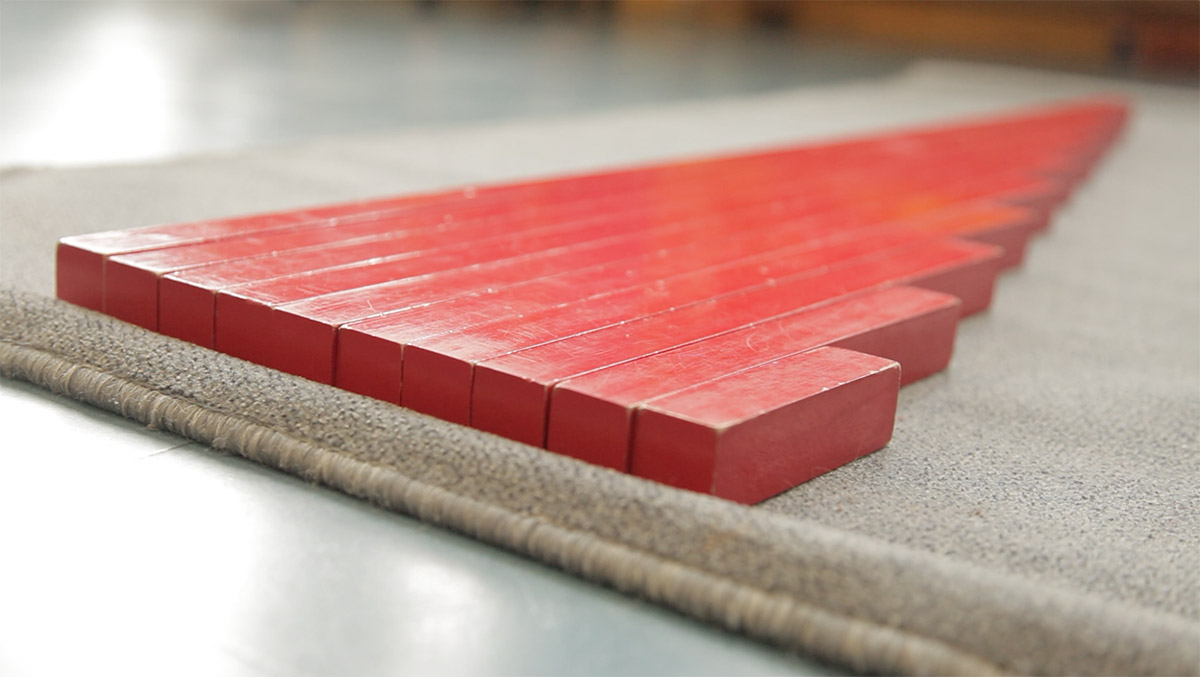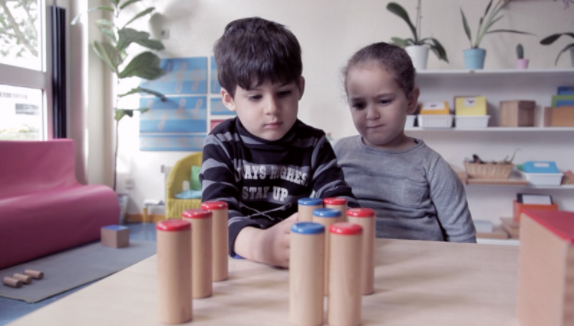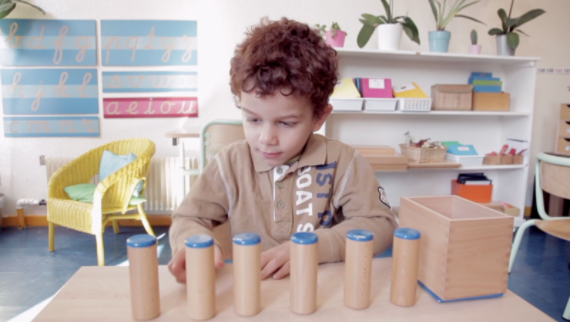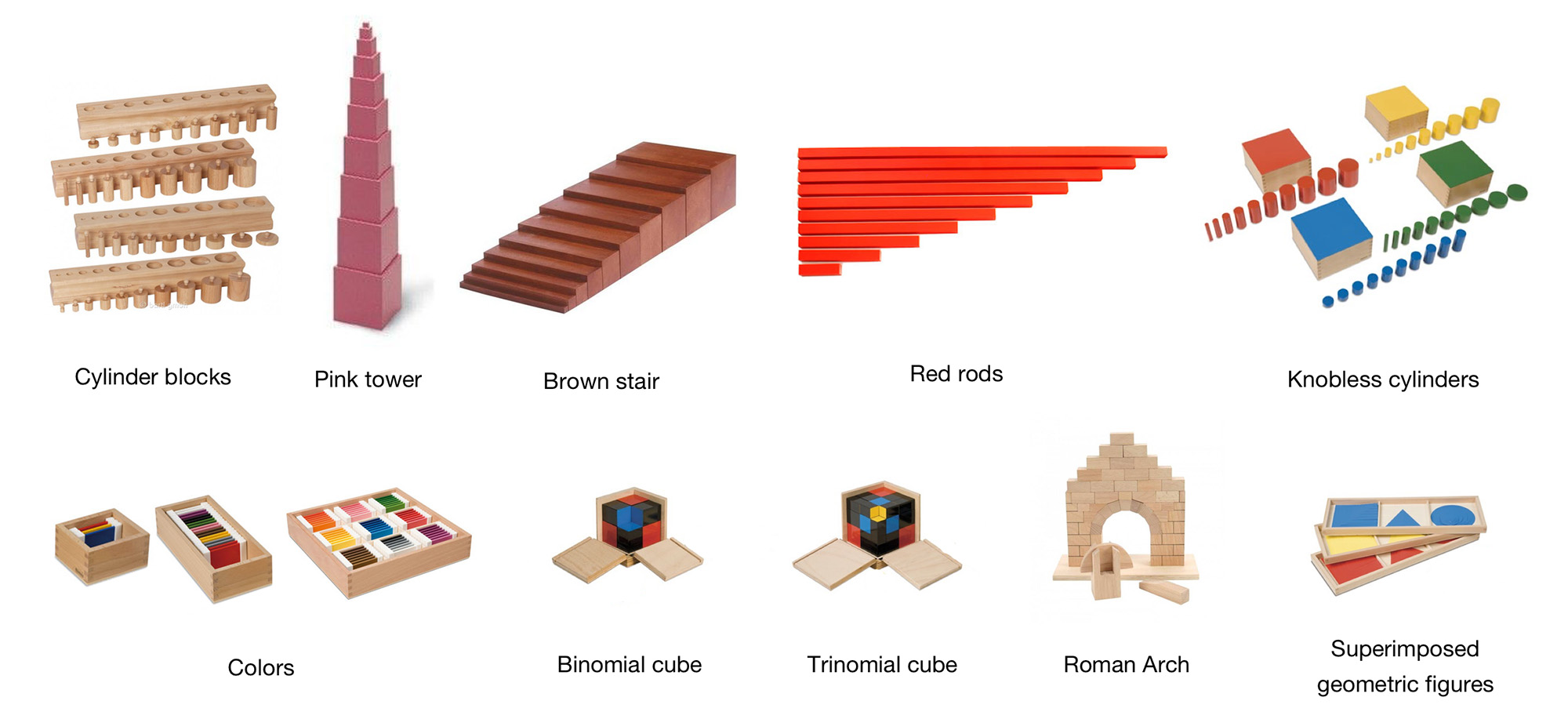Introduction to sense refinement activities
Children shape their intelligence through the visual, tactile, auditory, gustatory and olfactory information which comes from the world around them. These sensory impressions directly structure their brain, which is undergoing rapid development. Providing them with activities which refine their sensory capacities and perceptions - to enhance their ability to see, smell, hear, taste and touch - is therefore a valuable aid in helping them to develop their intelligence properly.
Honing sensory capacities
In order to hone these capacities in the classroom, we provided a range of sensory materials, some of which were designed by the French doctor Jean Itard. These materials were subsequently adopted and developed further by his disciple Édouard Séguin and then enriched by Dr Maria Montessori. 'The red rods were invented over one hundred years ago,' explained Dr Montessori at a conference in London in 19461, 'one hundred years before I began my work.' She went on: 'The pink tower was also used as a cognitive test forty years before I started my experimentations (...). I didn't invent the exercises myself; I took those that already existed and tested them on young children.'
Due to the cognitive clarity which they offer, their aesthetic appeal and their attractive colours and dimensions, these sensory materials engage the children's attention and involve them in an activity which enables them to refine their senses in a very effective way. However, there are doubtless other materials or activities which would produce a similar effect, so please feel free to choose the materials which seem most appropriate to you.
If you should decide to work with the classroom materials that we used, it is important to treat them in the same way as Maria Montessori did: not as something set in stone, but rather as a very fruitful starting point that we should free completely free to adapt to the contemporary world and to the individual child we are working with. The materials are only a means – the key element is the child, their personality and their personal rhythms.
Two important criteria for choosing activities
Here are two criteria of particular interest in helping children to hone their sensory capacities. Ideally, activities should be chosen with these two aspects in mind.
Isolating a single quality. The materials created by Itard, Séguin and Montessori are of great cognitive value because they isolate a single quality. With the Red Rods, for example, only the length varies, the colour and texture remaining constant. This means that the child's attention and intelligence are channelled exclusively into focusing on differences in length. The same applies to the Colour Tablets: only the colour varies, and the tablets are otherwise identical. Almost all of the sensory materials created by the three doctors isolate sensory qualities which the children can discriminate between, and this makes them very effective.

Putting together things that are the same, then grading them. Matching two things is a simple exercise that the children love and is an effective way for them to hone their senses. Grading requires a finer capacity for sensory discrimination and so we suggest you get the children to do this after they have done the matching.

Matching two identical sounds

Grading sounds from the loudest to the softest
Offering the world to the young child
The sense refinement materials that we select for our children should only ever be a complement to real life experiences which are vibrant, rich and varied: walking on sand or carpet, touching wood, painting, making pottery, playing in water, carrying pieces of wood to prepare a fire (and so comparing lengths and only taking the shortest and thinnest pieces, for example), preparing a fruit salad and naming all the pretty colours, listening to birdsong in the forest and trying to identify the birds, picking up dead leaves in the autumn and examining them, smelling coriander or the roses in the garden... It is about living to the full, and being fully present in the world. As simple and natural as all these sensory experiences may be, they are nevertheless also the experiences which nurture the child's flexible intelligence, which is developing rapidly at this young age, and they are quite simply irreplaceable. The classrooms materials we select for our children do not offer the children the content but rather a means of ordering this content: they help them to organise and name certain impressions that the world has already furnished them with.
Most of the child's sensory refinement takes place outside of these classroom activities: the key thing is to create a real, living environment and to propose activities as a complement which enable the children to order and appropriate for themselves the sensory information which their environment offers them.
Naming perceptions
Helping children to name their perceptions enables them to order the external world and to better appropriate it for themselves. Naming colours and their shades, naming the various dimensions (thick, thin, short, long, small, big), naming the various textures (rough, smooth, silk, cotton, linen, hemp) etc., also offers them a valuable means of developing their intelligence.
In Gennevilliers, when we wanted to transmit precise vocabulary to the children, such as the words for colours, we presented it in quite a formal way by using the highly effective three-stage lesson invented by Dr Édouard Séguin. Every teacher and parent should be aware of these three stages because they enable the child to memorise two or three new words in a remarkably effectively manner.
- The first stage consists of naming. This involves pointing at the colours and naming them, and then getting the child to repeat the words. We say 'red', pointing at something red, and the child repeats the word 'red'. Then we say 'blue', pointing at something blue, and wait for the child to repeat the word 'blue'. We do the same thing for 'yellow', and then we go through the same procedure several times again with the three colours, but over a short time span so as not to fatigue the child.
- The second stage consists of showing. We say to the child: 'Show me the yellow one.' They then point at the yellow object. 'Yes, it's yellow,' we say, confirming the name of the colour. Then we ask them to point at the other colours that we name in turn, always for a short time span and in a fun way. At this stage, the child is already starting to associate a name with an object or a concept, without yet being able to name it themselves. This second stage should be slightly longer than the others so that the children have a chance to properly memorise the vocabulary.
- The final stage consists of identifying. Pointing at a red tablet, we ask the child: 'What's this?' If the first two stages have elicited sufficient enthusiasm, they will reply (sometimes very loudly!): 'It's red!' We then do the same thing with the other two colours and we continue with this third stage until the new vocabulary appears to have been solidly acquired, remembering to shuffle around the tablets on the table (which greatly amuses the children).
More generally, we suggest you use very precise vocabulary in the presence of the children. The lexical rigour and variety which we demand of ourselves is a precious gift to our children. Using precise words to describe the rich variety of the world around them enhances children's ability to perceive their environment and to organise their impressions.
If you'd like to find out more, please view the videos in the 'Sense Refinement' section of the practical underpinning page.
1 'Education based on psychology' conference, Maria Montessori, 4 September 1946, in The 1946 London Lectures, Laren (Netherlands), Montessori-Pierson Publishing Company, 2012.


